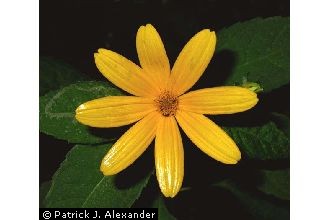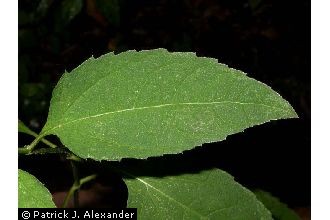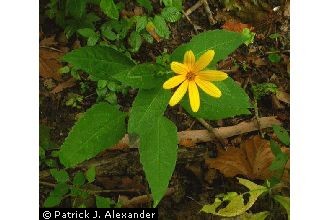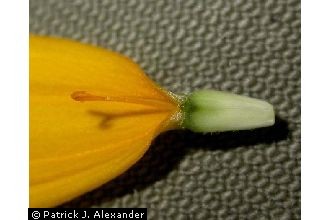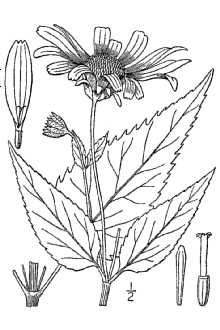Smooth Oxeye
Scientific Name: Heliopsis helianthoides (L.) Sweet
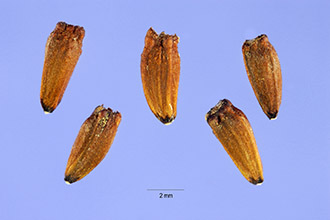
| General Information | |
|---|---|
| Usda Symbol | HEHE5 |
| Group | Dicot |
| Life Cycle | Perennial |
| Growth Habits | Forb/herb |
| Native Locations | HEHE5 |
Plant Guide
Uses
Forage: Livestock and deer sometimes graze smooth oxeye (Haddock, 2005). Its importance as a forage ranges from poor to good for cattle and sheep. Landscape: Smooth oxeye is considered one of the best hardy plants for a wildflower garden border (Runkel and Roosa, 1989). It is considered especially suited and valuable for planting in dry locations. The flowering period can be extended by removing spent flowers.
Status
Please consult the PLANTS Web site and your State Department of Natural Resources for this plant’s current status (e.g. threatened or endangered species, state noxious status, and wetland indicator values).
Description
General: The name Heliopsis is Greek in origin and means “sun-eye” and helianthoides is also Greek for “like a sunflower” (Denison, 1989). Smooth oxeye is a member of the sunflower family (Asteraceae). It is a vigorous, upright, native, perennial forb growing .5 to 1.5 meters (m) in height. The smooth, unbranched stem arises from a fibrous rooted caudex that develops stout rhizomes. The leaves are oppositely attached to the stem and have coarsely serrated margins. The leaves are triple nerved, petiolate (have short leaf petioles) and are broadly lance shaped tapering to a sharp point at the tip and are abruptly rounded at the base. The leaves are dark green above and lighter green below with siliceous based hairs that provide a rough texture on both surfaces. The stem apex may contain a single flower head or branch into multiple stems with many yellow flowers (Owensby, 1989). The flowers of Heliopsis have both orange-yellow center disk and yellow ray flowers. Individual flowers have 10 or more ray flowers. The ray flowers are fertile with a forked pistil (female flower parts) at their base, but contain no male flower parts (Lommasson, 1973). The central disk flowers are perfect in that they contain both male and female flower parts (Runkel and Roosa, 1989). The fruit is a smooth three or four angled achene, usually without a pappus or crown of hairs that aids in wind dissemination (Runkel and Roosa, 1989). Ray flowers produce the three angled achene and disk flower produce the more common 4 angled achene. Distribution: For current distribution, please consult the Plant Profile page for this species on the PLANTS Web site. Habitat: It is located in dry areas, edges of woods, roadsides, open woods, edges of fields and thickets. It can be found growing in the eastern half of Kansas and Nebraska and statewide in Missouri. It is found growing in association with warm season grasses of the tallgrass prairie. Although seldom abundant it is widely scattered among prairie grasses in glades and along stream and creek banks.
Adaptation
Smooth oxeye is adapted to full sunlight and dry to moderately moist soil conditions. It can be found growing in waste areas, roadsides, open woods, and edge of fields and thickets. It can be found on most tallgrass prairie sites and other open spaces, especially on dry soils (Runkel and Roosa, 1989). This species tolerates some drought and also a wide range of soil types, including nutrient poor soils.
Establishment
Plantings of Heliopsis seed should be made on a well prepared, weed free, firm seed bed. Fallowing fields prior to planting can have advantages in control of undesirable weeds and to ensure that no herbicide residues remain in the soil of the field. Smooth oxeye fields planted for seed production should be in rows (0.8 to 1.0 m) apart. A field with rows that are spaced approximately 0.9 m apart should have about 45 Pure Live Seeds (PLS) per 0.3 m of row. Seed planted in the spring between March and April should produce vigorous seedlings and can be expected to produce a seed crop the first growing season.
Management
Heliopsis will produce seed during its establishment year if environmental and management conditions are ideal, Seed maturity can be expected from mid-August to early September, Seed shatter can be a problem when the majority of seed heads have turned brown and seed maturity is reached, Harvest of smooth oxeye can be performed with a conventional combine with the proper settings and adjustments, The equipment settings offered here should be considered a starting point and modified as harvest demands change, Combine settings: 1) concave clearance 12 mm, 2) Cylinder speed 1000 RPMs, and 3) air intake at 15 percent, These settings are based on years of harvest experience at the PMC in Manhattan, KS, Freshly combined material should be dried carefully at no greater temperature than 43 degrees Centigrade (ºC) with a forced air system, Seed yield of native plant species can be variable, with production yields of 65 to 244 kg/ha, Under good growing conditions and proper management, smooth oxeye can be maintained in seed production stands for up to five years, Thus it may be considered a short lived perennial plant, Use soil moisture sensors to measure the soil moisture of Smooth Oxeye.,
Pests and Potential Problems
Smooth oxeye has no serious insect or disease problems, but has been observed to have some susceptibility to aphid attack.
Environmental Concerns
Concerns
Concerns
There are no environmental concerns or probability of this plant becoming a weed problem in cultivated agricultural systems or pasture lands. Rock (1981) however, indicates that Heliopsis may spread widely and has the tendency to become weedy in landscapes.
Seeds and Plant Production
Plant Production
Plant Production
The normal method of propagation of this species is through seed (achenes). Spring planting of this species is recommended. A cold, moist stratification period of 30 days at 4ºC can improve germination. Zlesak (2007) found that although the responses to germination cues were variable, improved germination of H. helianthoides can be generally achieved by imbibing ethephon (1 to 5 mM), exposure to red light (1.5 h), and providing at least one week of cold stratification (4ºC). There are approximately 277,200 achenes per kilogram. According to the Prairie Propagation Handbook (Rock, 1981) Heliopsis is easily seeded and divided, with division commonly being done in the fall. Rock (1981) also indicates that this species is easily transplanted and can be propagated using stem cuttings in the spring. Cultivars, Improved, and Selected Materials (and area of origin) Contact your local Natural Resources
Conservation
Service office for more information. Look in the phone book under “United States Government.” The Natural Resources Conservation Service will be listed under the subheading “Department of Agriculture”. ‘Midas’ a cultivar release from Kansas in 1984. It is adapted to the eastern half of Nebraska, Kansas, and Oklahoma and extends into western Iowa, Missouri and Arkansas. The germ plasm that was eventually selected and became Midas was originally collected in Greenwood County, Kansas in 1970. Midas is readily available through commercial seed producers. Central Iowa Germplasm is source identified material released in 1996, by Missouri. It is source material especially adapted to central Iowa. It is commercially available. Northern and Southern Iowa Germplasms were released in 1997, by Missouri and are source identified materials. They are materials selected for adaptability to those regions in Iowa and are commercially available.
References
Denison, E. 1989. Missouri Wildflowers. Missouri Department of Conservation. Jefferson City, MO. Farrar, J. 1990. Wildflowers of Nebraska and the Great Plains. NEBRASKAland Magazine. Lincoln, NE. Haddock, M.J. 2005. Wildflowers and Grasses of Kansas. University Press of Kansas. Lawrence, KS. Lommasson, R.C. 1973. Nebraska Wild Flowers. University of Nebraska Press. Lincoln, NE. Owensby, C.E. 1989. Kansas Prairie Wildflowers. Iowa State University Press. Ames, IA. Rock, H.W. 1981. Prairie Propagation Handbook. Wehr Nature Center. Milwaukee County Dept. of Parks, Recreation and Culture. Runkel, S.T. and D.M. Roosa. 1989. Wildflowers of the Tallgrass Prairie: The Upper Midwest. Iowa State University Press. Ames, IA. Zlesak, D.C. 2007. Factors affecting seed germination of Heliopsis helianthoides (L) Sweet. Seed Sci. and Technol. 35:577-594.
Fact Sheet
Alternative Names
Common Alternate Names: Early sunflower, Smooth sunflower, False sunflower, Oxeye daisy, Oxeye, Oxeye sunflower, Heliopsis sunflower, Sunflower Heliopsis.
Uses
Forage: Livestock and deer sometimes graze Smooth oxeye. Landscape: Smooth oxeye is considered one of the best hardy plants for a wildflower garden border. It performs well in dry (xeric) locations, in poor to average soils, and in full sun to partial shade. Flowering can be extended by removing spent flowers. Staking may be necessary in shady locations. Pollinators: The ground nesting bee, Holcopasites heliopis, is a specialist pollinator of Heliopsis helianthoides. The nectar of Heliopsis attracts butterflies and other pollinators. Birds utilize the seed as a food source, and stems provide winter cover for beneficial insects.
Status
Please consult the PLANTS Web site and your State Department of Natural Resources for this plant’s current status (e.g., threatened or endangered species, state noxious status, and wetland indicator values).
Description
Heliopsis from the Greek word helios for "sun" and opsis for "appearance." Helianthoides also from the Greek meaning "like Helianthus," the sunflower. Smooth oxeye is a member of the sunflower family (Asteraceae). It is a vigorous, upright, native, perennial forb growing 3’ to 4’ in height. The leaves are oppositely attached to the stem consistently to the top of the plant and have coarsely serrated margins. The toothed leaf blades are oval to triangular or lance-shaped. The stem is rough to the touch and may contain a single flower head or be branched at the apex into multiple stems with several yellow flowers. The flowers of Heliopsis have both orange-yellow center disk and yellow ray flowers. Blooming occurs in summer beginning in July to August and extends for up to two months, making it one of the earliest blooming sunflowers. Heliopsis forms clumps 2’ to 4’ in diameter.
Adaptation
Its native range is widely distributed mainly east of the Rocky Mountains from Ontario to Florida and Mississippi. Smooth oxeye is adapted to full sunlight and dry to moderately moist soil conditions. It can be found growing in prairies, roadsides, and open woods, edge of fields and thickets, and waste areas. This species tolerates some drought and also a wide range of soil types, including nutrient-poor soils. It has proven to perform best in areas receiving >5” of rainfall. Smooth oxeye is not salinity-tolerant. Smooth oxeye distribution from USDA-NRCS PLANTS Database. For updated distribution, please consult the Plant Profile page for this species on the PLANTS Web site. R. Alan Shadow, USDA NRCS Manhattan PMC
Establishment
Seed: Heliopsis helianthoides establishes readily from seed when planted in the winter/fall or early in spring (March to April). Germination generally starts four weeks after sowing if soil temperatures remain in the 60 – 70 degree Fahrenheit range. Seeds ripen approximately one month after flowering, however as with many Asters, plants are self sterile. It may be necessary to crack open a few seeds to make sure they are viable. Cuttings and Divisions: Five to seven node cuttings taken from the top 12 inches of growth in late spring root easily. Cuttings are sometimes reluctant to overwinter. Divide plants in the fall for best results.
Management
During the establishment period weeds should be mowed or spot treated with a herbicide. Plants will produce viable seed the first year of establishment in mid to late August to September. Seeds readily shatter when mature.
Pests and Potential Problems
None known at this time, , Use soil moisture sensors to measure the soil moisture of Smooth Oxeye.
Environmental Concerns
There are no environmental concerns or probability of this plant becoming a weed problem in cultivated agricultural systems or pasture lands. Rock (1981) however, indicates that Heliopsis may spread widely and has the tendency to become weedy in landscape settings. Cultivars, Improved, and Selected Materials (and area of origin) ‘Midas’ was released by the Manhattan, Kansas Plant Materials Center (PMC) in 1984. It is recommended for the more western extent of the native range of this species. Northern, central and southern Iowa source identified materials were released in the mid and late 1990’s by the Elsberry, Missouri Plant Materials Center. Prepared by: Christine Taliga; Plant Materials Specialist, USDA NRCS, Denver, Colorado. Richard L. Wynia; Plant Center Manager, USDA NRCS Manhattan Plant Materials Center, Manhattan, Kansas. Shawn V. Belt; Horticulturist, USDA NRCS, Norman A. Berg National Plant Materials Center, Beltsville, Maryland.

